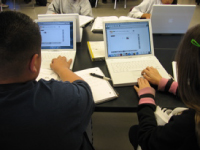COSEE California has been working closely with the National Marine Educators Association and COSEE-West over the last two years to develop the Scope and Sequence for the Ocean Literacy Principles. The Scope and Sequence is an educational resource for curriculum developers, program developers, standards committees, and informal and formal science educators. It uses conceptual flow diagrams to show how the fundamental concepts of the seven Principles can be taught appropriately at different grade bands and how the concepts are connected to each other. A conceptual flow diagram (CFD) is a type of concept map showing a logical, coherent and conceptually sound instructional sequence. There are a total of 28 CFDs, one CFD per Principle for four grade bands (K-2, 3-5, 6-8, & 9-12).
The process of developing these CFDs has been iterative and collaborative. In Phase 1, educators and scientists met in numerous working groups all across the country, including during annual meetings for NMEA and NSTA, to identify and discuss the concepts and ideas in each Principle that are appropriate for each grade band. These working groups created first drafts of each CFD.
During Phase 2, marine educators and curriculum developers at the Lawrence Hall of Science (LHS), in consultation with ocean scientists, spent over three months reviewing and revising the first drafts. Addressing each CFD individually, they clarified concept statements; organized and reorganized concepts; and elaborated on, expanded on, and broke down further the concepts identified in the first drafts.
In November 2008 we conducted the first Expert Review, which was open to all educators and scientists and occurred online on the virtual campus of the College of Exploration. Over 100 scientists and educators participated in asynchronous discussions on Caucus Space and synchronous conference calls using Marratech. They scrutinized, debated, discussed, and reworked the content, language, organization, and presentation of all 28 CFDs individually.
We just completed Phase 3, during which time educators and curriculum developers at LHS have been amending the CFDs in the light of the asynchronous and synchronous discussions. Additionally, they modified the CFDs one Principle at a time; that is, the CFDs for grades K-2, 3-5, 6-8, and 9-12 in each Principle were reviewed together in order to ensure progression of concepts and consistency in language.
We now begin the second Expert Review, which targets ocean scientists to examine the CFDs for scientific accuracy. Two or three scientists are being asked to review all four CFDs for each Principle; thus, anywhere 14 to 21 scientists are contributing to this second Expert Review. Educators, including classroom teachers, informal science educators, and curriculum developers, will be invited to take part in a separate Expert Review to establish appropriateness for grade levels, developmental levels, and standards.
At the same time, we are reworking the public website for the Ocean Literacy Network (OLN) so that it features the Scope and Sequence for the Ocean Literacy Principles. We are freshening up the look, navigation and content of the OLN website while maintaining the web links to the private online community of practice for OLN members. We will also add more interactive features that we hope will make the website more useful for science educators who want to include ocean topics across learning environments. We plan to debut the completed Scope and Sequence and the beta version of the new website at the Annual Meeting of NMEA in July.
We invite ocean scientists and educators who are interested in being an Expert Reviewer in these final phases of the development process to contact us. Please email Lynn Tran if interested.
| |  |
| Students collaborating with computers in a 21st Century Classroom |
COSEE California is making tremendous progress in our project Teaching Ocean Sciences in the 21st Century Classroom. Recent and rapid technological advances in computing, engineering, cyberinfrastructure, and communications are revolutionizing how scientific research is conducted and disseminated. Not surprisingly, technology is also shaping the future of K-12 instructional approaches for educators and their students. Students are increasingly dependent on the Web and mobile technologies as sources of information, a means to access and process data, and a forum for socializing and sharing ideas. The COSEE California Teaching Ocean Science in the 21st Century Classroom initiative seeks to embrace these scientific, educational and cultural changes by engaging students in learning activities that capitalize on evolving technology.
For example, information and communications technology (ICT) is making it ever easier to connect students to research labs remotely using simple video conferencing tools (e.g. Skype and Acrobat Connect) that allow students and researchers to interact in new ways. COSEE California is experimenting with these tools and approaches to identify effective practices in using ICT to provide students with insight into the research process and close, even personal, connections to the research community. At the same time, researchers, in particular graduate students, are learning about effective communication strategies, and how to align their presentations to specific classroom needs, all from the comfort of their own lab! Importantly, this next generation of ocean scientists is being empowered to carry what they learn into their future careers and outreach activities.
Last but not least, COSEE California has a new collaboration with University of Hawaii, Manoa to explore ways to incorporate traditional knowledge into our award-winning Communicating Ocean Sciences course. Read more about this exciting collaboration in another soon-to-be-published article on COSEE.net!
Visit COSEE California!

